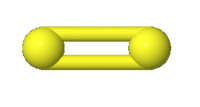Disulfur
 | |
| Names | |
|---|---|
| IUPAC name
Disulfur | |
| Other names
Diatomic sulfur Sulfur | |
| Identifiers | |
| 23550-45-0 | |
| ChEBI | CHEBI:29387 |
| ChemSpider | 4574100 |
| 753 | |
| |
| Jmol-3D images | Image |
| PubChem | 5460602 |
| |
| Properties | |
| Molecular formula |
S2 |
| Molar mass | 64.13 g·mol−1 |
| Dipole moment | 0 D |
| Thermochemistry | |
| Specific heat capacity (C) |
32.51 kJ K−1 mol−1 |
| Std molar entropy (S |
228.17 kJ K−1 mol−1 |
| Std enthalpy of formation (ΔfH |
128.60 kJ mol−1 |
| Related compounds | |
| Related compounds |
Triplet oxygen |
| Except where noted otherwise, data is given for materials in their standard state (at 25 °C (77 °F), 100 kPa) | |
| | |
| Infobox references | |
Disulfur is the diatomic molecule with the formula S2.[1] It is analogous to the dioxygen molecule but rarely occurs at room temperature. This violet gas is commonly generated by heating sulfur above 720 °C and comprises 99% of the vapor at low pressure (1 mm Hg) at 530 °C. S2 is one of the minor components of the atmosphere of Io, which is predominantly composed of SO2.[2] Diatomic molecules are common containing C, O, N, and F, but for heavier elements they are often only stable at high temperatures.
Production
Disulfur results when an atmosphere of COS is irradiated with UV light using a mercury photosensitizer or when CS2, H2S2, S2Cl2 or C2H4S are photolyzed. Singlet S2 is also formed when sulfur compounds such as H2S, PSF3 or COS are photolyzed. S2 can be generated by heating various organosulfur precursors.[3]
Properties
S2 exists in the triplet state (is a diradical, with two unpaired electrons) like O2 and SO. It has the S-S double bond length of 189 pm, much shorter than the S-S single bonds in S8, which are 206 pm long. In its Raman spectrum, the S-S vibrational band is observed at 715 cm−1.[4] The corresponding vibrational band of O-O is found at 1122 cm−1. The S-S bond energy is 265 kJ/mol compared to 498 kJ/mol for O2.
Sulfur has a large number of allotropes, perhaps as many as thirty. Their specific properties are distinguishable by various types of spectroscopy. The only stable form of sulfur at normal conditions is S8.[5]
References
- ↑ Steudel, Ralf; Eckert, Bodo (2003). "Solid Sulfur Allotropes". Elemental Sulfur and Sulfur-Rich Compounds I. Topics in Current Chemistry 230. pp. 58–68. doi:10.1007/b12110. ISBN 978-3-540-40191-9.
- ↑ Lellouch, E. (January 2005). "Io's Atmosphere and Surface-Atmosphere Interactions". Space Science Reviews 116 (1–2): 211–224. Bibcode:2005SSRv..116..211L. doi:10.1007/s11214-005-1957-z.
- ↑ Tardif, Sylvie L.; Rys, Andrzej Z.; Abrams, Charles B.; Abu-Yousef, Imad A.; Lesté-Lasserre, Pierre B. F.; Schultz, Erwin K. V.; Harpp, David N. (1997). "Recent chemistry of the chalcogen diatomics". Tetrahedron 53 (36): 12225. doi:10.1016/S0040-4020(97)00555-3.
- ↑ Eckert, Bodo; Steudel, Ralf (2003). "Molecular Spectra of Sulfur Molecules and Solid Sulfur Allotropes". Elemental Sulfur and Sulfur-Rich Compounds II. Topics in Current Chemistry 231. pp. 181–191. doi:10.1007/b13181. ISBN 978-3-540-40378-4.
- ↑ A. F. Holleman, N. Wiberg. Inorganic Chemistry. Academic Press; Berlin ; New York : De Gruyter, 2001.ISBN 0-12-352651-5.